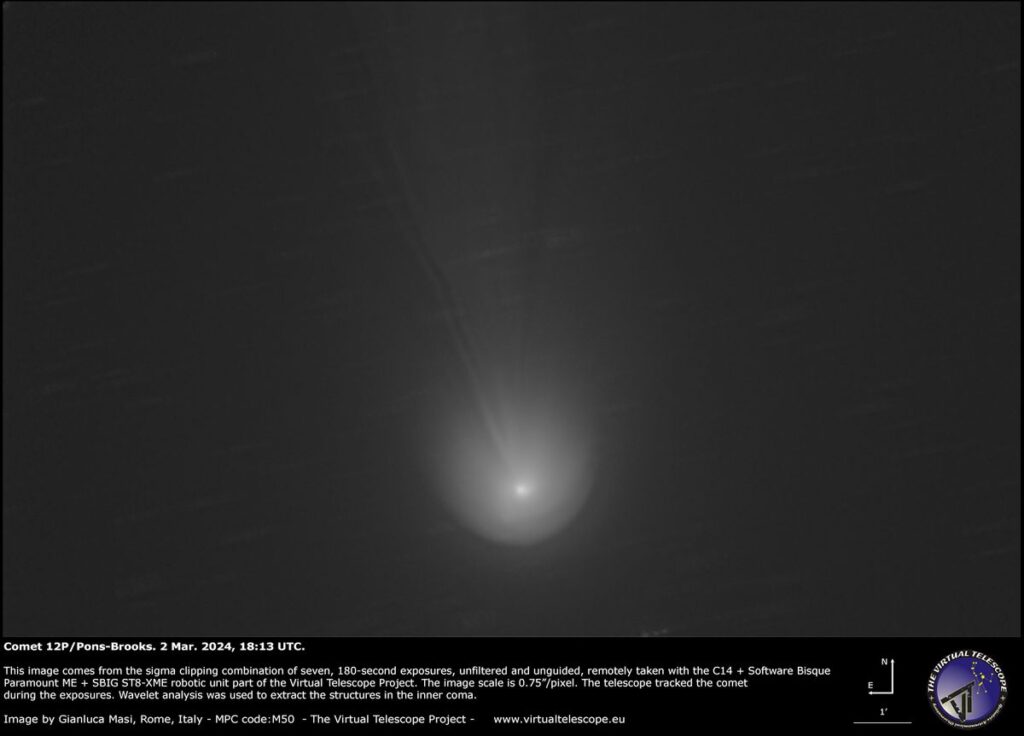astronomy
Unveiling the Mysteries of Comet 12P/Pons Brooks: The Devil Comet’s Rare Celestial Show
Explore the enigmatic beauty of Comet 12P/Pons Brooks, the “Devil Comet,” as it graces our skies with rare eruptions and celestial displays.
Comet 12P/Pons Brooks, known as the “devil comet,” is an intriguing celestial visitor that has captured the attention of astronomers and stargazers alike. This comet, with a diameter of about 10.5 miles (17 kilometers), follows a highly elliptical orbit around the sun, completing its journey approximately every 71 years. What sets 12P apart is its cryovolcanic nature – an ice volcano in space.

The icy shell of 12P occasionally erupts due to solar radiation, releasing a mix of ice and gas known as cryomagma into space. This process significantly expands the comet’s coma, the cloud of gas and dust surrounding its nucleus, making it appear brighter for a few days. In July 2023, astronomers witnessed 12P erupt after nearly 70 years, with subsequent eruptions occurring more frequently.
During earlier eruptions, the comet’s expanded coma gave it a unique appearance resembling demonic horns. However, recent observations show that these horns seem to have vanished, replaced by a distinctive green glow caused by high levels of dicarbon in its coma and tail, a rare phenomenon in comets.
For sky watchers in the Northern Hemisphere, viewing opportunities are optimal before April 21, when 12P makes its closest approach to the sun. Post this date, the comet will become visible to those in the Southern Hemisphere until the year’s end. To catch a glimpse, head to the countryside away from city lights. While visible to the naked eye, binoculars can enhance the viewing experience.
12P has surprised observers with unexpected brightness, including a rare flare that transformed its gas cloud into a horseshoe shape, earning it monikers like the Devil Comet or Millennium Falcon Comet. Additional flares have been detected, hinting at potential future surprises as the comet approaches Earth.
The cause of these flare-ups remains a mystery, with some astronomers speculating about rare volcanic activity on the comet’s surface. When planning a stargazing outing, target days closest to a new moon to avoid moonlight interference. Checking the weather forecast is essential to ensure clear skies for optimal viewing conditions.
Upon arrival at your stargazing spot, allow your eyes time to adjust to the darkness, especially if you’ve been exposed to bright screens. Patience is key, as celestial wonders like Comet 12P/Pons Brooks often reveal themselves gradually, rewarding those willing to wait.
As you gaze at this unique cosmic spectacle, reflect on the transient nature of comets and the vast mysteries of the universe they represent. The journey of Comet 12P serves as a poignant reminder of the beauty and unpredictability of celestial phenomena, inviting us to marvel at the wonders of the cosmos and contemplate our place within it.
https://www.space.com/watch-comet-12p-pons-brooks-zoom-past-andromeda-galaxy-livestream
